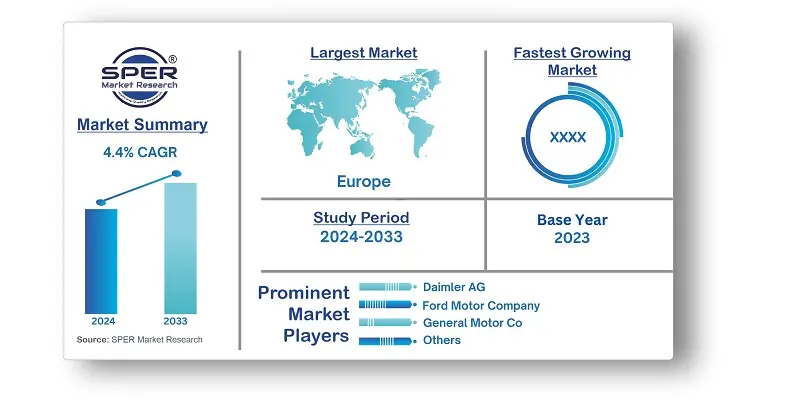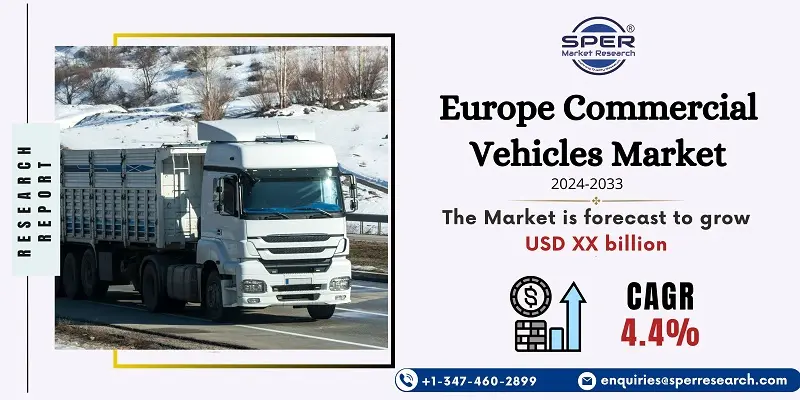
Europe Commercial Vehicles Market Growth, Size, Trends, Share, Revenue and Future Competition
Europe Commercial Vehicles Market Size- By Type, By Mode of Transportation, By Service, By End User- Regional Outlook, Competitive Strategies and Segment Forecast to 2033
| Published: Mar-2024 | Report ID: AMIN2476 | Pages: 1 - 159 | Formats*: |
| Category : Automotive & Transportation | |||


| Report Metric | Details |
| Market size available for years | 2020-2033 |
| Base year considered | 2023 |
| Forecast period | 2024-2033 |
| Segments covered | By Type, By End-Use Industry |
| Regions covered | France, Germany, Italy, Russia, Spain, UK, Rest of Europe |
| Companies Covered | Bosch Rexroth AG (Robert Bosch GmbH), Daimler AG, Ford Motor Company, General Motor Co., Honda Motor Co. Ltd., Hyundai Motor Company, Mahindra & Mahindra Limited (Mahindra Group), Tata Motors Limited, Toyota Motor Corporation, Volkswagen AG, Others |
- Logistics and Transportation Companies
- Construction and Infrastructure Development Firms
- Manufacturing and Industrial Enterprises
- Government and Municipal Authorities
- Fleet Management Companies
- Automotive Dealerships and Distributors
- Rental and Leasing Agencies
- Commercial Vehicle Manufacturers
- Others
| By Type: |
|
| By End-Use Industry: |
|
| By Region: |
|
- Europe Commercial Vehicles Market Size (FY’2024-FY’2033)
- Overview of Europe Commercial Vehicles Market
- Segmentation of Europe Commercial Vehicles Market By Type (Buses & Coaches, Heavy Trucks, Light Commercial Vehicles)
- Segmentation of Europe Commercial Vehicles Market By End-Use Industry (Industrial, Logistics, Mining & Construction, Passenger Transportation, Others)
- Statistical Snap of Europe Commercial Vehicles Market
- Expansion Analysis of Europe Commercial Vehicles Market
- Problems and Obstacles in Europe Commercial Vehicles Market
- Competitive Landscape in the Europe Commercial Vehicles Market
- Impact of COVID-19 and Demonetization on Europe Commercial Vehicles Market
- Details on Current Investment in Europe Commercial Vehicles Market
- Competitive Analysis of Europe Commercial Vehicles Market
- Prominent Players in the Europe Commercial Vehicles Market
- SWOT Analysis of Europe Commercial Vehicles Market
- Europe Commercial Vehicles Market Future Outlook and Projections (FY’2024-FY’2033)
- Recommendations from Analyst
1.1. Scope of the report1.2. Market segment analysis
2.1. Research data source2.1.1. Secondary Data2.1.2. Primary Data2.1.3. SPER’s internal database2.1.4. Premium insight from KOL’s2.2. Market size estimation2.2.1. Top-down and Bottom-up approach
2.3. Data triangulation
4.1. Driver, Restraint, Opportunity and Challenges analysis4.1.1. Drivers4.1.2. Restraints4.1.3. Opportunities4.1.4. Challenges4.2. COVID-19 Impacts of the Global Refurbished Medical Equipment Market
5.1. SWOT Analysis5.1.1. Strengths5.1.2. Weaknesses5.1.3. Opportunities5.1.4. Threats5.2. PESTEL Analysis5.2.1. Political Landscape5.2.2. Economic Landscape5.2.3. Social Landscape5.2.4. Technological Landscape5.2.5. Environmental Landscape5.2.6. Legal Landscape5.3. PORTER’s Five Forces5.3.1. Bargaining power of suppliers5.3.2. Bargaining power of buyers5.3.3. Threat of Substitute5.3.4. Threat of new entrant5.3.5. Competitive rivalry5.4. Heat Map Analysis
6.1. Global Refurbished Medical Equipment Market Manufacturing Base Distribution, Sales Area, Product Type6.2. Mergers & Acquisitions, Partnerships, Product Launch, and Collaboration in Global Refurbished Medical Equipment Market
7.1. Global Refurbished Medical Equipment Market Value Share and Forecast, By Product, 2024-20337.2. Intensive care equipment7.3. Medical Imaging7.4. OR Equipment7.5. Patient Monitors
8.1. Global Refurbished Medical Equipment Market Value Share and Forecast, By Application, 2024-20338.2. Cardiology8.3. Neurology8.4. Oncology8.5. Urology
9.1. Global Refurbished Medical Equipment Market Value Share and Forecast, By End User, 2024-20339.2. Diagnostic Imaging Centres9.3. Hospital
10.1. Global Refurbished Medical Equipment Market Size and Market Share
11.1. Global Refurbished Medical Equipment Market Size and Market Share By Product (2020-2026)
11.2. Global Refurbished Medical Equipment Market Size and Market Share By Product (2027-2033)
12.1. Global Refurbished Medical Equipment Market Size and Market Share By Application (2020-2026)
12.2. Global Refurbished Medical Equipment Market Size and Market Share By Application (2027-2033)
13.1. Global Refurbished Medical Equipment Market Size and Market Share By End User (2020-2026)13.2. Global Refurbished Medical Equipment Market Size and Market Share By End User (2027-2033)
14.1. Global Refurbished Medical Equipment Market Size and Market Share By Region (2020-2026)14.2. Global Refurbished Medical Equipment Market Size and Market Share By Region (2027-2033)14.3. Asia-Pacific14.3.1. Australia14.3.2. China14.3.3. India14.3.4. Japan14.3.5. South Korea14.3.6. Rest of Asia-Pacific14.4. Europe14.4.1. France14.4.2. Germany14.4.3. Italy14.4.4. Spain14.4.5. United Kingdom14.4.6. Rest of Europe14.5. Middle East and Africa14.5.1. Kingdom of Saudi Arabia14.5.2. United Arab Emirates14.5.3. Rest of Middle East & Africa14.6. North America14.6.1. Canada14.6.2. Mexico14.6.3. United States14.7. Latin America14.7.1. Argentina14.7.2. Brazil14.7.3. Rest of Latin America
15.1. Agito Medical A/S15.1.1. Company details15.1.2. Financial outlook15.1.3. Product summary15.1.4. Recent developments15.2. Block Imaging15.2.1. Company details15.2.2. Financial outlook15.2.3. Product summary15.2.4. Recent developments15.3. DRE Medical15.3.1. Company details15.3.2. Financial outlook15.3.3. Product summary15.3.4. Recent developments15.4. Everx Pvt Ltd.15.4.1. Company details15.4.2. Financial outlook15.4.3. Product summary15.4.4. Recent developments15.5. General Electric Company15.5.1. Company details15.5.2. Financial outlook15.5.3. Product summary15.5.4. Recent developments15.6. Integrity Medical Systems15.6.1. Company details15.6.2. Financial outlook15.6.3. Product summary15.6.4. Recent developments15.7. Koninklijke Philips N.V.15.7.1. Company details15.7.2. Financial outlook15.7.3. Product summary15.7.4. Recent developments15.8. Radiology Oncology Systems Inc.15.8.1. Company details15.8.2. Financial outlook15.8.3. Product summary15.8.4. Recent developments15.9. Siemens AG15.9.1. Company details15.9.2. Financial outlook15.9.3. Product summary15.9.4. Recent developments15.10. Soma Technology15.10.1. Company details15.10.2. Financial outlook15.10.3. Product summary15.10.4. Recent developments15.11. Others
SPER Market Research’s methodology uses great emphasis on primary research to ensure that the market intelligence insights are up to date, reliable and accurate. Primary interviews are done with players involved in each phase of a supply chain to analyze the market forecasting. The secondary research method is used to help you fully understand how the future markets and the spending patterns look likes.
The report is based on in-depth qualitative and quantitative analysis of the Product Market. The quantitative analysis involves the application of various projection and sampling techniques. The qualitative analysis involves primary interviews, surveys, and vendor briefings. The data gathered as a result of these processes are validated through experts opinion. Our research methodology entails an ideal mixture of primary and secondary initiatives.



Frequently Asked Questions About This Report
PLACE AN ORDER
Year End Discount
Sample Report
Pre-Purchase Inquiry
NEED CUSTOMIZATION?
Request CustomizationCALL OR EMAIL US
100% Secure Payment






Related Reports
Our Global Clients
Our data-driven insights have influenced the strategy of 200+ reputed companies across the globe.




















